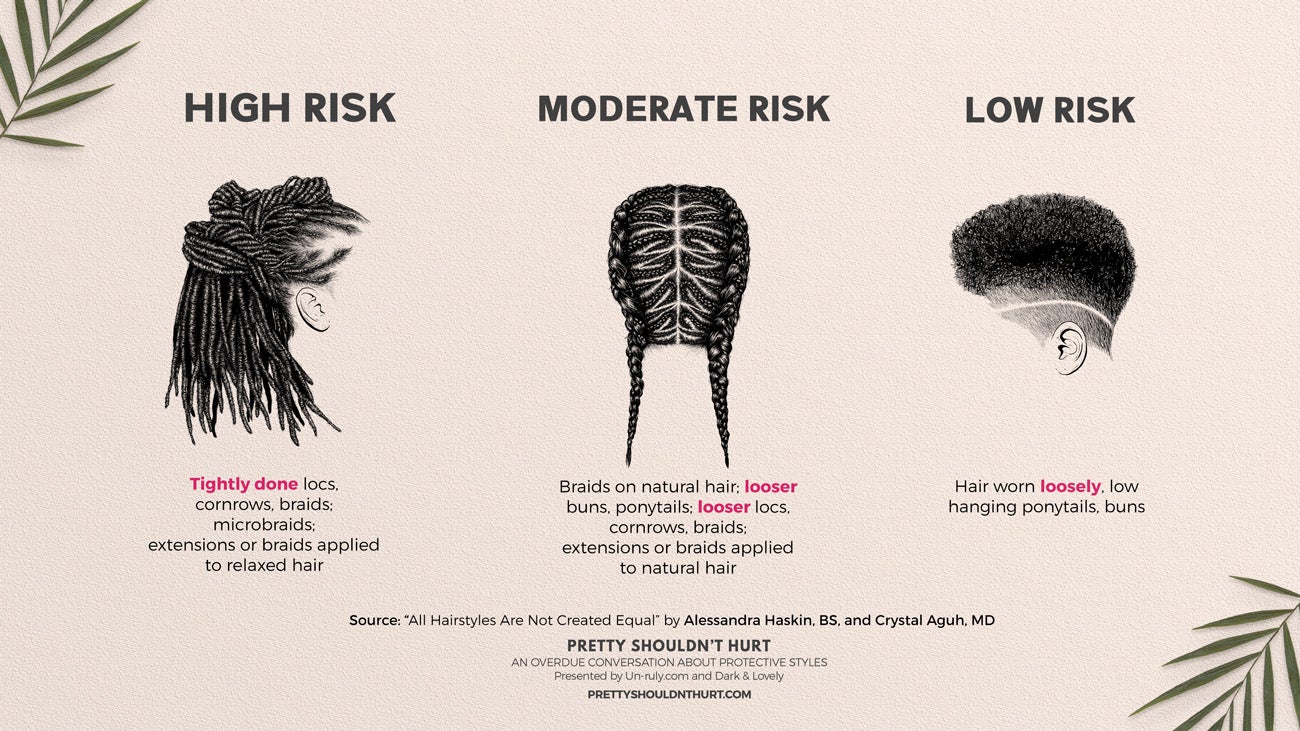As the natural hair movement forges on more Black women are rediscovering their love for box braids, faux locs, and other styles that have been in the community for decades—for some, centuries. And in the last ten years they’ve also begun to group these hairdos under a new title: protective styles. But we’ve seen from countless destroyed hairlines that when executed poorly, or not cared for, these beautiful styles can cause traction alopecia and other damage to the hair.
In her new short documentary Pretty Shouldn’t Hurt: An Overdue Conversation About Protective Styles, presented by Un-ruly.com and Dark & Lovely, avid protectivetarget=”_blank” rel=”noreferrer noopener” aria-label=”board certified dermatologist Crystal Aguh, M.D. (opens in a new tab)”>board certified dermatologist Crystal Aguh, M.D. and celebrity hairstylist and Dark & Lovely spokesperson Derick Monroe, for tips on how women can protect their hair from their protective style.
Be vocal. Hairstyling shouldn’t cause you pain, so if it does, tell your stylist immediately. “As many of us grow up being taught to respect our elders (with that respect often being shown in the form of silence), this can translate to loss of empowerment while in a stylist’s chair,” says Aguh. “Additionally, many people develop very personal relationships with their stylist and are careful not to offend them, even when they are in pain. I understand these feelings and encourage my patients to seek out a new stylist if they don’t feel like their current one creates a safe space for feedback. Women should feel just as empowered to seek out a new stylist as they would seeking a new doctor if they felt their needs were not being met.”
Be careful with the ratio of added hair to natural hair. While alopecia happens on an individual basis, Aguh identifies certain hairstyles as high risk, moderate-risk, and low-risk for tension. All hairstyles are not created equal according to her study and any style that incorporates additional hair requires a proper measurement. One inch of your hair should have no more than one inch of added hair. Excessive extensions adds weight and puts tension on the hair follicles, causing eventual breakage.
 Courtesy of Crystal Aguh, M.D.
Courtesy of Crystal Aguh, M.D.
Proper removal of protectivetarget=”_blank” rel=”noreferrer noopener” aria-label=”Dark & Lovely’s Detangling Cream (opens in a new tab)”>Dark & Lovely’s Detangling Cream,” Derick explains. “It’s enriched with peppermint oil and is great because it melts all the debris that builds up on the base. The important point is to have slip and make sure you get all the hair that may have shed out before shampooing, or else you can end up with serious knots and tangles.”
Take breaks from protective styles. Dr. Aguh suggests a four weeks in, four weeks out method. And if you’ve stopped putting tension on your hair and still see damage, seek professional help. “Women should seek medical evaluation by a board-certified dermatologist if they are dealing with any form of progressive hair loss to make sure they receive an accurate diagnosis and appropriate treatment,” she says. “Most people do well with over the counter treatments, like minoxidil, but some women may require more aggressive treatment that involves prescription medication. If there is no response to any form of medication then surgery is often required to fully restore the hairline.”
Invest in products specifically to care for protective styles. “Products can make or break your natural style,” Derick adds. “Gels and sprays full of alcohol can dry the scalp and the hair out. Some that aren’t soluble can sit on the hair causing flaking and build up. Dark and lovely has created the first line dedicated to protective styles and with ingredients that soothes and moisturizes such as peppermint oil, aloe, and avocado oil.”
FIRST LOOK: “Pretty Shouldn’t Hurt” premieres July 22nd at 7:00pm EST. Watch live with us on YouTube or Facebook!We’re so excited to be releasing this film. It’s been a long time coming and we’ve poured lots of love into it. A good amount of us can probably relate to sitting in a chair, bearing through the pain of getting your hair done, and just accepting it as part of the process. But we’re officially rejecting the idea that beauty is pain, especially when it comes to our crowns. A lot of amazing people came together for this project: The @DarkandLovely team, @drkariwill, @derickmonroe, @anupres, @crystalaguhmd, our very own @weareyeluchi hairstylists and many more. All in an effort to set new rules for protective styling that truly are protective.#PrettyShouldntHurt#ProtectiveStyles#Cornrows #Crochets #BoxBraids #PassionTwists #SpringTwists #KnotlessBoxBraids #GoddessBraids #FauxLocs #FeedinBraids #FeedinCornrows #MarleyTwists #SenegaleseTwists #ProtectiveHair>A post shared by UN-RULY (@hairunruled) on Jul 16, 2020 at 4:36pm PDT
Pretty Shouldn’t Hurt: An Overdue Conversation About Protective Styles premieres on July 22 on Un-ruly’s YouTube and Facebook pages.
The post Is That Protective Style Actually Protecting Your Hair? appeared first on Essence.


